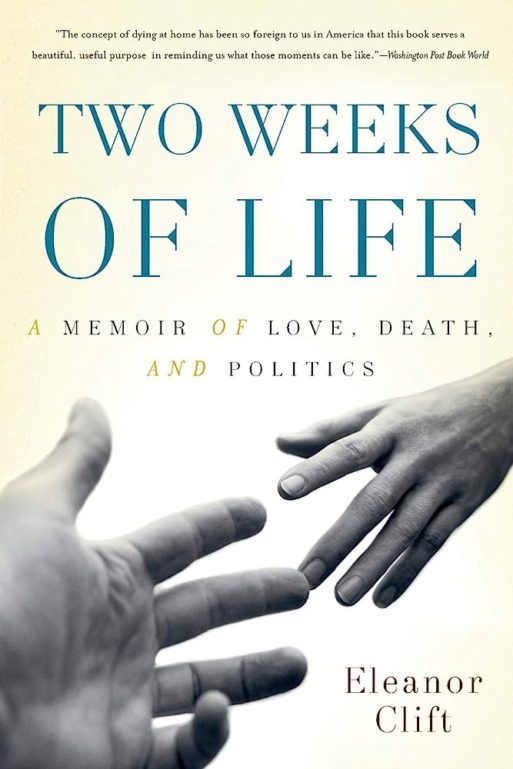 Eleanor Clift’s husband, Tom Brazaitis, died in 2005. For years, the Newsweek journalist cared for Tom, who had been diagnosed with kidney cancer in 1999, and towards the end she took him home to spend his final days in his own bed, situated in the living room (Tom was too weak to go up the stairs).
Eleanor Clift’s husband, Tom Brazaitis, died in 2005. For years, the Newsweek journalist cared for Tom, who had been diagnosed with kidney cancer in 1999, and towards the end she took him home to spend his final days in his own bed, situated in the living room (Tom was too weak to go up the stairs).
Two Weeks of Life, part memoir, part journalistic piece, was undertaken shortly after Tom’s death. Even as she cared for her husband, Clift continued to work as a reporter and columnist—work helped as a distraction from the grief in her personal life. So when, also in 2005, the Terri Schiavo case blew up in Florida, Clift was ready to write about it. As she says, this book “emerged out of these parallel experiences” of losing her husband to cancer and watching the nation riveted by the right-to-die debate.
The book touches on numerous end-of-life-related topics, from right-to-die to the importance of hospice and palliative care. Clift recounts how, when the doctor suggested hospice, her husband brightened at the prospect of being allowed to go home and live in comfort, while she cried because she knew it meant he had six months or less to live.
Yet despite her hesitation, Clift notes that hospice was a great experience, as close to a “good death” as anyone could hope for. The hospice workers comforted both her and her husband in a time of great difficulty—you can hear in this account a strong argument for keeping hospice care alive in America.
Clift’s intention was to refrain from overtly discussing the political; however, with such highly-charged subject matter, this is a nearly impossible task. Clift lays much of the blame for the politicization of the Schiavo case, and its unnecessarily public and painful development, at the feet of the far right and fundamentalist activists. While displaying sympathy for both Schiavo’s husband—who wanted to halt Terri’s treatment—and Schiavo’s parents—who wanted to keep her alive—Clift juxtaposes Terri’s public and prolonged death with Tom’s private, mostly natural experience in his own living room. It’s a powerful contrast, and it truly opens up the conversation about death as taboo, death as inevitability, and death as natural and healthy in America. Based on Schiavo’s experiences, that conversation needs to be had.
The book is particularly poignant as it is set against the emotional backdrop of Eleanor Clift’s grief. A year after Tom’s death, Clift writes, she visited her grandmother’s grave in Germany and found herself meditating on the significance of her experience. “Standing in a church cemetery by the gravestone of my father’s mother, who had died soon after giving birth to him, I felt immersed in the seamlessness of life and death. Tom was gone, but what did that mean?”
Clift continued to speak out loud to her husband on occasion when she was home alone, grieving in her own, personal way. “I find myself fantasizing about breaking into the columbarium at Arlington, where the individual niches are sealed, and liberating Tom,” she writes in the last pages. “It’s totally irrational, but imagining is my way of remembering.”

 Two Weeks of Life by Eleanor Clift
Two Weeks of Life by Eleanor Clift



 Our Annual Seven Holiday Gifts for Someone Who Is Grieving, 2024 Edition
Our Annual Seven Holiday Gifts for Someone Who Is Grieving, 2024 Edition

 “Hands Up to the Sky” by Michael Franti & Spearhead
“Hands Up to the Sky” by Michael Franti & Spearhead















A compelling review of two overlapping experiences. There is a lot remaining to explore on this topic. Only those who have gone through an experience like this would understand. In the end we all have a destiny with death.
Report this comment
It seem so long since Terri’s case and yet it still remains greatly important to our progressing forward to understanding ethics in dying.
Report this comment